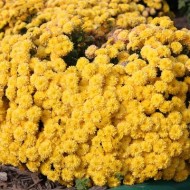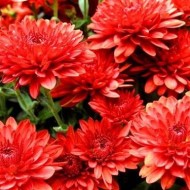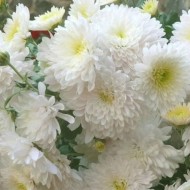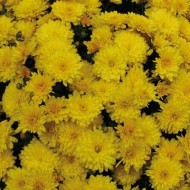Growing spherical chrysanthemum multiflora in the country: advice from gardeners
Content
- 1 Characteristics and description of the flower
- 2 Video "Caring for chrysanthemum multiflora"
- 3 Interesting varieties and varieties
- 4 Secrets of planting spherical chrysanthemums
- 5 Rules for the care of a spherical chrysanthemum
- 6 Reproduction of chrysanthemum multiflora
- 7 Diseases and pests of chrysanthemum multiflora
Characteristics and description of the flower
Spherical chrysanthemum is a short, rounded shrub. Plant height ranges from 20 to 70 cm.Based on this parameter, three types of multiflora are distinguished:
- super short (20-30 cm);
- medium-sized (30–40 cm);
- tall (60–70 cm).
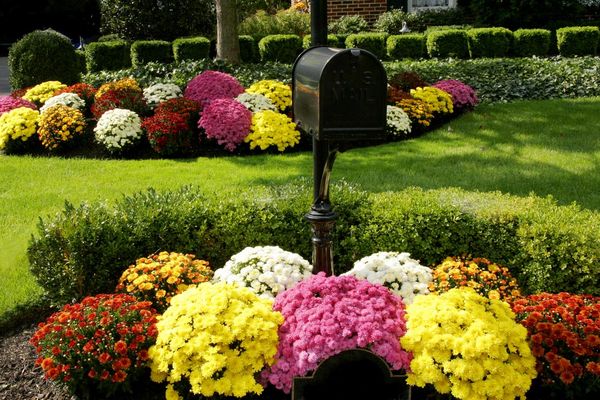
Blooming, the bushes are abundantly covered with small flowers of various colors. Multiflora has a long flowering period - up to 2 months. By the time of the beginning of budding, all varieties are classified as follows:
- early (August);
- medium (September);
- late (October).
The spherical chrysanthemum does not like frost and does not tolerate winter well. To prevent the flower from freezing, experienced gardeners do not recommend leaving it outdoors.
Video "Caring for chrysanthemum multiflora"
This video will show you how to care for multiflora chrysanthemums in your garden.
Interesting varieties and varieties
There are more than 30 types of multiflora in the world. Below are the popular varieties that are suitable for growing in the southern regions and the Moscow region:
- Bransky Plum. Tall variety, up to 70 cm tall. The color of the inflorescences is pink-scarlet. Blossoms in early autumn.
- Branroyal Yellow. The size of the bush is 60–70 cm. Starting from the end of August, it is covered with a thick cap of a sunny shade.
- Branbeach Orange. Medium-sized orange multiflora with a delicate creamy sheen. The diameter of the bush does not exceed 50 cm. It blooms in mid-August.
- Brandove White. Snow-white flowers with a light green core form pompons that cover a bush 0.5 m high. It blooms with the beginning of autumn.
- Branchili. The height of the multiflora is 40 cm. From the middle of September it is covered with a cap of a rich red hue.
- Branindio. Medium-sized variety, 0.5 m high, blooming in early autumn. Flowers are bright yellow with an orange core.
- Branindio
- Branchili
- Brandove white
- Branbeach orange
- Branroyal yellow
- Bransky plum
Secrets of planting spherical chrysanthemums
The chrysanthemum reaches its maximum size only by the end of summer, before blooming. To prevent the flower from losing its spherical appearance, it is recommended to replant it every 3 years.
Lighting requirements
Multiflora is very demanding on lighting. Immediately after disembarkation, the duration of daylight hours for a chrysanthemum should not be less than 14 hours. This regime is observed for 1 month.When bud formation begins, the duration is shortened to 8-11 hours and is no longer changed until the end of flowering.
Air temperature and humidity
Saplings are planted in open ground at a temperature of +18 ° C. For the normal formation of the bush, as well as budding, the degree is increased to 20-25 ° C. At the same time, it should be a little colder at night - only 16–20 ° С.
Multiflora feels comfortable when the air humidity is 50%. This indicator is maintained by irrigation with a spray gun or by arranging containers with water.
Substrate requirements
The soil mixture for growing chrysanthemums should not exceed 40% of the total soil volume. It includes:
- peat or river sand;
- vermiculite;
- perlite.
Such a substrate absorbs and retains moisture well, maintains a stable temperature of the environment. Thanks to vermiculite and perlite, the topsoil does not grow moldy.
The soil for replanting should contain peat, coarse sand, humus and be slightly acidic.
Landing in open ground
The landing site is prepared before wintering. The soil is fertilized with humus and wood ash, well dug up.
Planting holes are dug in sunny areas, keeping a distance of 50–70 cm. Multiflora grown by cuttings begin to be planted from the end of April. Adult flowers are transplanted from flowerpots in July-August. After planting, the plant is watered abundantly.
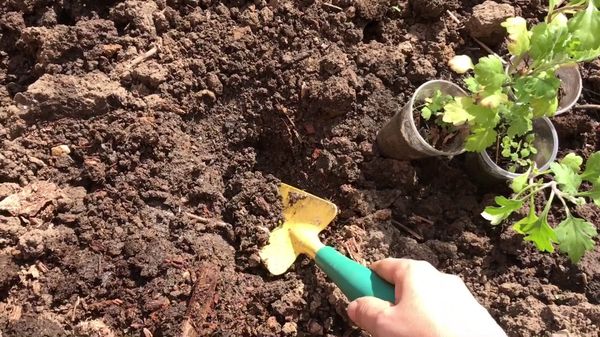
Planting in containers and pots
So that the chrysanthemum does not slow down the flowering rate, it is transplanted after the opening of more than half of the buds. The pot is selected depending on the size of the flower, with a depth of at least 25 cm and a diameter of 25 cm. The substrate is chosen fertile, of medium density. Too light soil mixture will dry out quickly, which will negatively affect the multiflora.
Rules for the care of a spherical chrysanthemum
The globular chrysanthemum is an undemanding plant. However, in order for multiflora to bloom profusely and feel comfortable, it is necessary to follow some rules for caring for it.
Watering features
The flower loves moisture very much, so you need to moisten the soil often and a lot. On dry summer days, watering is carried out every day in the morning or in the evening, when there is no direct sunlight. In rainy weather and abundant soaking of the earth around the bushes, the procedure can be skipped.
Top dressing and fertilization
Chrysanthemums are fertilized only at the root, making sure not to splatter the green part of the plant. Top dressing is carried out in two stages:
- On the 20th day after landing. Nitrogen-containing compositions are introduced.
- During bud formation. The soil is fertilized with potassium-phosphorus preparations with the addition of bird droppings.
Post-flowering care
Pruning of spherical chrysanthemums is carried out at the end of autumn, before wintering. Only 10 cm of the aboveground part is left above the surface. It is from it that in the spring the plant will give new young shoots, which will independently take the desired shape.
Places of cuts are treated with copper-containing preparations. They will help protect the multiflora from pathogens that can cause powdery mildew or other fungal diseases.
Preparing for winter
In regions with warm winters, chrysanthemums are usually not harbored. Under them, it is enough just to loosen the soil and cover it with dry leaves on top. But the flowers of the middle lane require more careful preparation. The cut bushes are covered with coniferous spruce branches, on which humus is placed next. The land around the multiflora is dug up, organic fertilizers are applied, and then mulched with straw or needles.
Chrysanthemums growing in flowerpots are brought into the room for the winter.
Reproduction of chrysanthemum multiflora
Reproduction of spherical chrysanthemums is a simple procedure. It can be done in three ways, following the step-by-step instructions.
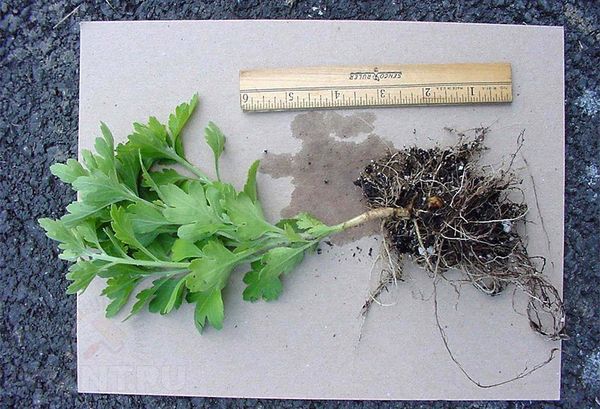
Growing from seeds
- a drainage layer is placed in containers for seedlings, a soil mixture is poured on top;
- moisten the soil and place the planting material;
- cover with foil;
- carry out regular irrigation and ventilation;
- after the appearance of the first shoots, a pick is carried out;
- 2 times a month, fertilizing with nitrogen-containing compounds is done;
- as soon as the seedlings reach 15–20 cm, they are transplanted into open ground.
It is better to sow seeds for seedlings in late winter - early spring.
Cuttings
- with the onset of spring, cuttings are cut with a length of 10 cm;
- cut off the lower leaves;
- stand for 24 hours in a root solution;
- seedling containers are filled with layers: sand, soil mixture, calcined sand;
- sticks in the processes, keeping a distance of 8 cm;
- leave the planted cuttings for 15 days, providing them with high humidity and a comfortable temperature;
- after rooting, they are planted in open ground.
Dividing the bush
- dig up an adult bush;
- carefully divide the rhizome;
- inspect and remove damaged areas;
- transplanted to a new place;
- watered abundantly and fertilized with organic compounds.
Diseases and pests of chrysanthemum multiflora
Globular chrysanthemums are relatively resistant to fungal diseases. The most common multiflora problem is powdery mildew. To get rid of the infection, it is enough to treat the plant with a special fungicide.
Flowers are most susceptible to insect pests. Spraying with soapy water or a diluted metronidazole tablet will help with aphids. The spider mite does not like high humidity, so you can deal with it with the help of abundant watering on the leaf. Caterpillars are collected by hand or the plant is treated with wood ash.
It is not for nothing that flower growers love to decorate their areas with multiflora. Highly decorative chrysanthemums are equally beautiful singly and in composition with other flowers.

